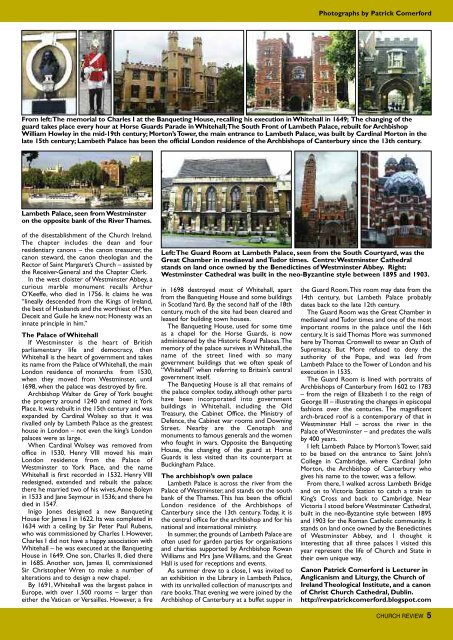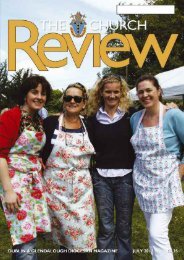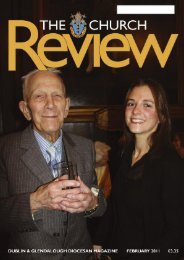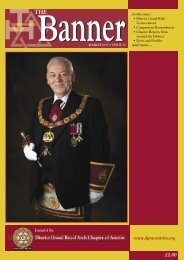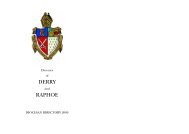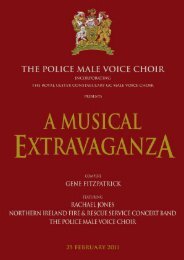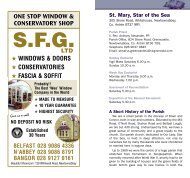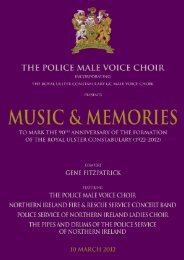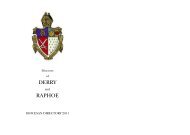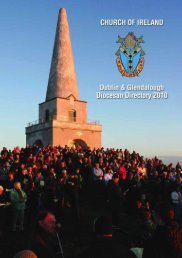around the parishes...
around the parishes...
around the parishes...
You also want an ePaper? Increase the reach of your titles
YUMPU automatically turns print PDFs into web optimized ePapers that Google loves.
Photographs by Patrick Comerford<br />
From left: The memorial to Charles I at <strong>the</strong> Banqueting House, recalling his execution in Whitehall in 1649; The changing of <strong>the</strong><br />
guard takes place every hour at Horse Guards Parade in Whitehall; The South Front of Lambeth Palace, rebuilt for Archbishop<br />
William Howley in <strong>the</strong> mid-19th century; Morton’s Tower, <strong>the</strong> main entrance to Lambeth Palace, was built by Cardinal Morton in <strong>the</strong><br />
late 15th century; Lambeth Palace has been <strong>the</strong> official London residence of <strong>the</strong> Archbishops of Canterbury since <strong>the</strong> 13th century.<br />
Lambeth Palace, seen from Westminster<br />
on <strong>the</strong> opposite bank of <strong>the</strong> River Thames.<br />
of <strong>the</strong> disestablishment of <strong>the</strong> Church Ireland.<br />
The chapter includes <strong>the</strong> dean and four<br />
residentiary canons – <strong>the</strong> canon treasurer, <strong>the</strong><br />
canon steward, <strong>the</strong> canon <strong>the</strong>ologian and <strong>the</strong><br />
Rector of Saint Margaret’s Church – assisted by<br />
<strong>the</strong> Receiver-General and <strong>the</strong> Chapter Clerk.<br />
In <strong>the</strong> west cloister of Westminster Abbey, a<br />
curious marble monument recalls Arthur<br />
O’Keeffe, who died in 1756. It claims he was<br />
“lineally descended from <strong>the</strong> Kings of Ireland,<br />
<strong>the</strong> best of Husbands and <strong>the</strong> worthiest of Men.<br />
Deceit and Guile he knew not: Honesty was an<br />
innate principle in him.”<br />
The Palace of Whitehall<br />
If Westminster is <strong>the</strong> heart of British<br />
parliamentary life and democracy, <strong>the</strong>n<br />
Whitehall is <strong>the</strong> heart of government and takes<br />
its name from <strong>the</strong> Palace of Whitehall, <strong>the</strong> main<br />
London residence of monarchs from 1530,<br />
when <strong>the</strong>y moved from Westminster, until<br />
1698, when <strong>the</strong> palace was destroyed by fire.<br />
Archbishop Walter de Grey of York bought<br />
<strong>the</strong> property <strong>around</strong> 1240 and named it York<br />
Place. It was rebuilt in <strong>the</strong> 15th century and was<br />
expanded by Cardinal Wolsey so that it was<br />
rivalled only by Lambeth Palace as <strong>the</strong> greatest<br />
house in London – not even <strong>the</strong> king’s London<br />
palaces were as large.<br />
When Cardinal Wolsey was removed from<br />
office in 1530, Henry VIII moved his main<br />
London residence from <strong>the</strong> Palace of<br />
Westminster to York Place, and <strong>the</strong> name<br />
Whitehall is first recorded in 1532. Henry VIII<br />
redesigned, extended and rebuilt <strong>the</strong> palace;<br />
<strong>the</strong>re he married two of his wives, Anne Boleyn<br />
in 1533 and Jane Seymour in 1536; and <strong>the</strong>re he<br />
died in 1547.<br />
Inigo Jones designed a new Banqueting<br />
House for James I in 1622. Its was completed in<br />
1634 with a ceiling by Sir Peter Paul Rubens,<br />
who was commissioned by Charles I. However,<br />
Charles I did not have a happy association with<br />
Whitehall – he was executed at <strong>the</strong> Banqueting<br />
House in 1649. One son, Charles II, died <strong>the</strong>re<br />
in 1685. Ano<strong>the</strong>r son, James II, commissioned<br />
Sir Christopher Wren to make a number of<br />
alterations and to design a new chapel.<br />
By 1691, Whitehall was <strong>the</strong> largest palace in<br />
Europe, with over 1,500 rooms – larger than<br />
ei<strong>the</strong>r <strong>the</strong> Vatican or Versailles. However, a fire<br />
Left: The Guard Room at Lambeth Palace, seen from <strong>the</strong> South Courtyard, was <strong>the</strong><br />
Great Chamber in mediaeval and Tudor times. Centre: Westminster Ca<strong>the</strong>dral<br />
stands on land once owned by <strong>the</strong> Benedictines of Westminster Abbey. Right:<br />
Westminster Ca<strong>the</strong>dral was built in <strong>the</strong> neo-Byzantine style between 1895 and 1903.<br />
in 1698 destroyed most of Whitehall, apart<br />
from <strong>the</strong> Banqueting House and some buildings<br />
in Scotland Yard. By <strong>the</strong> second half of <strong>the</strong> 18th<br />
century, much of <strong>the</strong> site had been cleared and<br />
leased for building town houses.<br />
The Banqueting House, used for some time<br />
as a chapel for <strong>the</strong> Horse Guards, is now<br />
administered by <strong>the</strong> Historic Royal Palaces. The<br />
memory of <strong>the</strong> palace survives in Whitehall, <strong>the</strong><br />
name of <strong>the</strong> street lined with so many<br />
government buildings that we often speak of<br />
“Whitehall” when referring to Britain’s central<br />
government itself.<br />
The Banqueting House is all that remains of<br />
<strong>the</strong> palace complex today, although o<strong>the</strong>r parts<br />
have been incorporated into government<br />
buildings in Whitehall, including <strong>the</strong> Old<br />
Treasury, <strong>the</strong> Cabinet Office, <strong>the</strong> Ministry of<br />
Defence, <strong>the</strong> Cabinet war rooms and Downing<br />
Street. Nearby are <strong>the</strong> Cenotaph and<br />
monuments to famous generals and <strong>the</strong> women<br />
who fought in wars. Opposite <strong>the</strong> Banqueting<br />
House, <strong>the</strong> changing of <strong>the</strong> guard at Horse<br />
Guards is less visited than its counterpart at<br />
Buckingham Palace.<br />
The archbishop’s own palace<br />
Lambeth Palace is across <strong>the</strong> river from <strong>the</strong><br />
Palace of Westminster, and stands on <strong>the</strong> south<br />
bank of <strong>the</strong> Thames. This has been <strong>the</strong> official<br />
London residence of <strong>the</strong> Archbishops of<br />
Canterbury since <strong>the</strong> 13th century. Today, it is<br />
<strong>the</strong> central office for <strong>the</strong> archbishop and for his<br />
national and international ministry.<br />
In summer, <strong>the</strong> grounds of Lambeth Palace are<br />
often used for garden parties for organisations<br />
and charities supported by Archbishop Rowan<br />
Williams and Mrs Jane Williams, and <strong>the</strong> Great<br />
Hall is used for receptions and events.<br />
As summer drew to a close, I was invited to<br />
an exhibition in <strong>the</strong> Library in Lambeth Palace,<br />
with its unrivalled collection of manuscripts and<br />
rare books. That evening we were joined by <strong>the</strong><br />
Archbishop of Canterbury at a buffet supper in<br />
<strong>the</strong> Guard Room. This room may date from <strong>the</strong><br />
14th century, but Lambeth Palace probably<br />
dates back to <strong>the</strong> late 12th century.<br />
The Guard Room was <strong>the</strong> Great Chamber in<br />
mediaeval and Tudor times and one of <strong>the</strong> most<br />
important rooms in <strong>the</strong> palace until <strong>the</strong> 16th<br />
century. It is said Thomas More was summoned<br />
here by Thomas Cromwell to swear an Oath of<br />
Supremacy. But More refused to deny <strong>the</strong><br />
authority of <strong>the</strong> Pope, and was led from<br />
Lambeth Palace to <strong>the</strong> Tower of London and his<br />
execution in 1535.<br />
The Guard Room is lined with portraits of<br />
Archbishops of Canterbury from 1602 to 1783<br />
– from <strong>the</strong> reign of Elizabeth I to <strong>the</strong> reign of<br />
George III – illustrating <strong>the</strong> changes in episcopal<br />
fashions over <strong>the</strong> centuries. The magnificent<br />
arch-braced roof is a contemporary of that in<br />
Westminster Hall – across <strong>the</strong> river in <strong>the</strong><br />
Palace of Westminster – and predates <strong>the</strong> walls<br />
by 400 years.<br />
I left Lambeth Palace by Morton’s Tower, said<br />
to be based on <strong>the</strong> entrance to Saint John’s<br />
College in Cambridge, where Cardinal John<br />
Morton, <strong>the</strong> Archbishop of Canterbury who<br />
gives his name to <strong>the</strong> tower, was a fellow.<br />
From <strong>the</strong>re, I walked across Lambeth Bridge<br />
and on to Victoria Station to catch a train to<br />
King’s Cross and back to Cambridge. Near<br />
Victoria I stood before Westminster Ca<strong>the</strong>dral,<br />
built in <strong>the</strong> neo-Byzantine style between 1895<br />
and 1903 for <strong>the</strong> Roman Catholic community. It<br />
stands on land once owned by <strong>the</strong> Benedictines<br />
of Westminster Abbey, and I thought it<br />
interesting that all three palaces I visited this<br />
year represent <strong>the</strong> life of Church and State in<br />
<strong>the</strong>ir own unique way.<br />
Canon Patrick Comerford is Lecturer in<br />
Anglicanism and Liturgy, <strong>the</strong> Church of<br />
Ireland Theological Institute, and a canon<br />
of Christ Church Ca<strong>the</strong>dral, Dublin.<br />
http://revpatrickcomerford.blogspot.com<br />
ChurCh review 5


